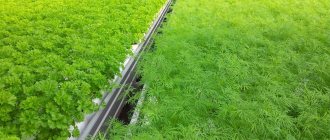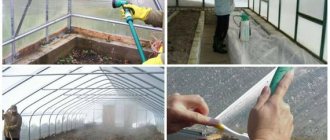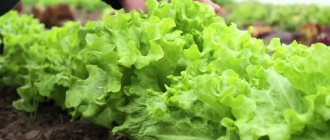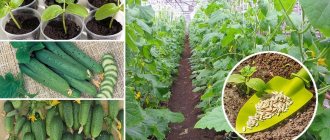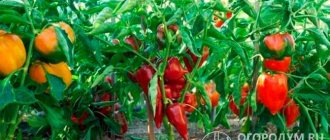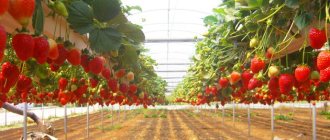In March, and in some places already in February, the sun begins to warm up, the snow melts and it smells like spring outside the window.
I really want fresh, vitamin-rich and aromatic spring salads. Many people can’t wait to get down to dacha chores. It's time to talk about planting greenery in a greenhouse in early spring. Greenhouses are used for growing heat-loving crops, and therefore they are transplanted there when consistently warm weather arrives. This happens around April-May. Until this point, you can use the greenhouse to grow cold-resistant plants starting in February-March, depending on the weather and region.
Despite the unpretentiousness of early greens, for seeds to germinate, the air temperature must be at least 5 °C, including at night. In a greenhouse, such conditions are created, of course, earlier than outside. The daytime sun quickly heats the air to quite tropical levels. At night, the temperature inside is only 3-4 degrees higher than outside, provided there are no cracks.
You can also raise the temperature another 2-3 degrees:
- Install the arcs and cover them with film or covering material, including 2-3 layers, that is, make a greenhouse in a greenhouse.
- Cover the plantings with bottles (1.5-5 liters) of water. During the day it will heat up and at night it will release heat inside the greenhouse.
Using these tricks, you can start planting early greens in an unheated greenhouse when the temperature outside at night approaches -2°C
The main selection criteria are early maturity and ability to withstand cold. Here is a list of what can be grown in a greenhouse in early spring:
Radish
Radishes in a greenhouse in spring
One of the most cold-resistant and fastest-growing crops, there are varieties that produce a harvest 3-4 weeks after sowing. In addition, spring is the most favorable time for growing it. After all, radishes like it to be humid, not hot, and have short daylight hours.
The seeds are placed at a distance of about 4 cm from each other, an interval of 15 cm is left between the rows. Radishes germinate at a temperature of 3-4°C, but 8-20°C is considered optimal.
Varieties suitable for early planting in a greenhouse: French Breakfast, 18 days, Zarya, Zhara
Arugula
Another wonderful representative of the cruciferous family is spicy arugula.
This vegetable is extremely healthy due to its high iodine content and a number of vitamins. There are very early varieties (Poker, Speedy, Rococo), which allow you to get a good harvest 21 days after germination. Arugula can tolerate frosts down to -5-7°C. And the optimal temperature for its growth is considered to be 16-18°C.
To achieve the ideal taste, arugula is planted at a distance of 8 centimeters between plants and 30 centimeters between rows. With thickened plantings, the taste of the leaves deteriorates.
Arugula can grow in the shade, but it does much better with good lighting and abundant watering. Lack of moisture immediately affects the quality of the crop: the leaves become rough and bitter. Remember that fertilizing is contraindicated for arugula, because it quickly accumulates nitrates.
Leaf salad
Leaf lettuce
A fast-growing vegetable, the first harvest can be harvested in 25 days. It is quite cold-resistant, almost as good as radish, but unlike the latter it is very light-loving. It is better to plant it on the south side of the greenhouse. We leave a distance of about 10 cm between the plants, and arrange them in the rows in a checkerboard pattern, then there will be enough light for it.
Varieties suitable for early planting in a greenhouse: Winter, Sorvanets, Moscow greenhouse, Emerald lace, Parliament
Dill
Early harvest of dill
A fragrant seasoning, not a single dish can do without it. Dill is cold-resistant, not afraid of frost and grows quickly. To speed up germination, it is recommended to soak it twice in hot water until it cools. It is better to sow thicker in wide rows, and when the foliage grows by 10 cm, pull out whole bunches, thinning out in this way.
Varieties suitable for early planting in a greenhouse: Carousel, Dukat, Kibray, Almaz, Iney
Parsley
Parsley is a storehouse of vitamin C. In winter, the body needs this greenery.
The plant loves light, fertile soil. Not afraid of the cold. Tolerates light frosts. If the winter is warm, she will not need heating in the greenhouse until December. At twelve degrees, parsley is comfortable. At temperatures above twenty, its leaves begin to fade.
Parsley is very unpretentious and grows well in a greenhouse
The following conditions are created for parsley.
- Artificial lighting during short days;
- Humidity – up to 75 percent;
- Periodic ventilation;
- Avoid sudden temperature fluctuations;
- The soil should be light loamy or soddy-podzolic (better); fertilizers should be applied very sparingly.
Parsley is grown in a greenhouse from seeds or root crops.
Algorithm for growing parsley from seeds
- After soaking, the seeds are sown in the ground.
Before sowing, keep the seeds in gauze at room temperature for five days, then another decade at +2 Celsius.
- We plant with a pattern of 5x10 centimeters for each plant, two grams of seeds per square, sowing depth - two centimeters.
- After planting, smooth out the grooves and moisten the soil abundantly.
- In a week we will get shoots. They need to be thinned out, leaving the strongest ones.
- Then the parsley grows on its own. If necessary, remove weeds.
- When the parsley grows to a height of twenty centimeters (at 16 degrees this will happen in three weeks), the plants are cut with a sharp knife.
- You cannot feed the plants before the first cut. After receiving the first harvest, it is watered with a solution of 14 grams of nitrogen-potassium fertilizers per twenty liters of water.
- Each harvest can reach one and a half kilograms per square. In winter it is possible to harvest up to seven harvests, from September to December - twice.
Algorithm for growing from root crops
Growing parsley from a root vegetable is somewhat more difficult.
This method is more labor-intensive. But it is economical: in one harvest, up to eight kilograms of greens are obtained in this way.
- For planting, healthy root crops are selected, having an upper bud, five to eight centimeters in length, weighing about seventy kilograms. A good variety is Harvest Sugar.
- We keep the root vegetables in sand at a temperature of about plus two degrees.
- Across the beds, every fifteen centimeters we make grooves with a depth of the entire length of the root. We wet them generously.
- We plant the root crops at an angle of 45° to the soil, leaving 5 centimeter intervals between them.
- Sprinkle with earth, sand or ash, two hundred grams per square.
- Lightly press down the soil and water again.
- After the first watering, it is necessary to water only after the soil has dried and to the very roots.
- When the leaves reach a height of 25 centimeters, they are cut off
Bow on feather
Onions for feathers in a greenhouse
You can have fresh green onions at home all year round, but it’s simply a sin not to plant them in a greenhouse. For forcing greens, last year's medium-sized bulbs or sets are used. Before planting the bulbs, you can cut off the top rough layer at the bottom and soak for 30-60 minutes.
You can grow onions with seeds, but this will take longer and it may simply not have time to plant the main crops. There is an option to plant seeds for seedlings in February at home, and with the onset of warm days, plant them in a greenhouse. It is better to soak the seeds before sowing or even germinate them.
It is better to pull out the grown onion entirely along with the bulb, and not to tear off the feathers, unless at the very beginning, until they reach the optimal height of 20-25 cm.
Varieties suitable for early planting in a greenhouse: Edelweiss, Farmersky early, Red feather, Emerald, Bogatyr
Perennial crops: sorrel, rhubarb and more
There is another great way to get early greenery on your site - to grow perennial, cold-resistant, early-ripening crops.
These include: sorrel, asparagus, rhubarb, spinach, chard, two-year-old arugula (Solitaire variety), wild garlic, perennial onions (schnitt, batun, slime). Almost all of these crops do not require special care, they feel good in shaded areas and are the very first to emerge from the ground, delighting us with fresh green leaves or juicy petioles every spring.
We wish you success and great harvests!
Chinese kale
Chinese cabbage in the greenhouse
A popular ingredient for light dietary salads. It grows a little longer than others (about 50 days) and is less cold-resistant, so it is planted later and closer to the center of the greenhouse. Seeds are sown at a distance of 30-40 cm in the row and between the rows. You can grow seedlings on a windowsill, then they will definitely have time to produce an early harvest in the greenhouse.
Varieties suitable for early planting in a greenhouse: Spring Beauty, Spring Jade, Champion
Preparing beds before planting early greens
Before sowing seeds, the beds must be dug up, adding organic or mineral fertilizer in the process. If this was done in the fall, all that remains is to loosen the soil. To speed up the warming of the earth, you can spill the earth with hot water and potassium permanganate. This will be an additional treatment of the soil against pathogens. In the fall, you can make warm ridges; planting on them is possible earlier than on ordinary ones. If you build a greenhouse or cover the ridges with film, the earth will warm up faster. You can also place hot water bottles on the ground.
How to sow seeds for an early harvest of greens in a greenhouse
Sowing seeds in the ground
You can use the entire area of the greenhouse for sowing. At the same time, you can plant a lot of greenery, or increase the distance between plants so that they have enough light and nutrition. Then, before planting tomatoes and peppers, you will have to harvest the entire crop. Or you can plant spring greens only along the edge or in the center of the ridges (between future rows of the main crop) and continue to use the greenhouse crop in May-June until the one planted in open ground arrives. Personally, I prefer this option.
We prepare grooves for seeds 1-2 cm deep, no more. It is better to scrape off the soil with a small shovel, push it with the edge of a board, or use egg grates to mark holes for seeds.
We place seeds in the prepared grooves/holes at the distance recommended for each crop. If the seeds have been soaked, they need to be dried a little in a napkin or cloth, otherwise they will stick to your hands. For small seeds, you can use a special dispenser or mix them with sand so that they are not sown too thickly.
It is best to cover the seeds with peat, this will make it easier for the seeds to hatch. But if there is no peat, you can use ordinary soil or buy ready-made soil. After the seeds are covered, they need to be watered well, preferably with warm water. Just don’t overdo it, otherwise the seeds may be washed away where they shouldn’t be or they will float to the surface.
To make the seeds germinate faster, and also if the weather is not yet quite suitable, cover the planting site with film or make a greenhouse. In the future, all you have to do is water the plantings, making sure that the soil does not dry out, but remains moist. Some time after watering, the soil must be carefully loosened so that a crust does not form on the surface.
Greenhouse in a greenhouse
Planting greenery in a greenhouse in early spring is not at all a tricky matter, although it requires compliance with certain conditions. Now you know how to do it. If you wish, you can even organize a business for growing and selling early greens. Have a fragrant and vitamin-rich harvest!
Borago - borage
As one of the components of vitamin-rich vegetable salads, you can use borage herb, the taste of which is identical to the taste of fresh cucumber. It is recommended to plant the plant as early as possible, as it is resistant to cold temperature conditions, increases in mass very quickly, and grows in partial shade.
In hot, non-rainy weather, the leaves of the plant become coarser and the grass tends to bloom quickly. When borage blooms, its flowers can also be used as food. They are collected, covered with sugar and used to decorate desserts, including cakes.
Borage grass is planted in furrows at a distance of 10 centimeters. When caring for the plant, it is necessary to maintain soil moisture, not allow it to dry out, and also make a one-time fertilizing with an infusion of herbs. The plant is also resistant to pests; it has no pests.
